
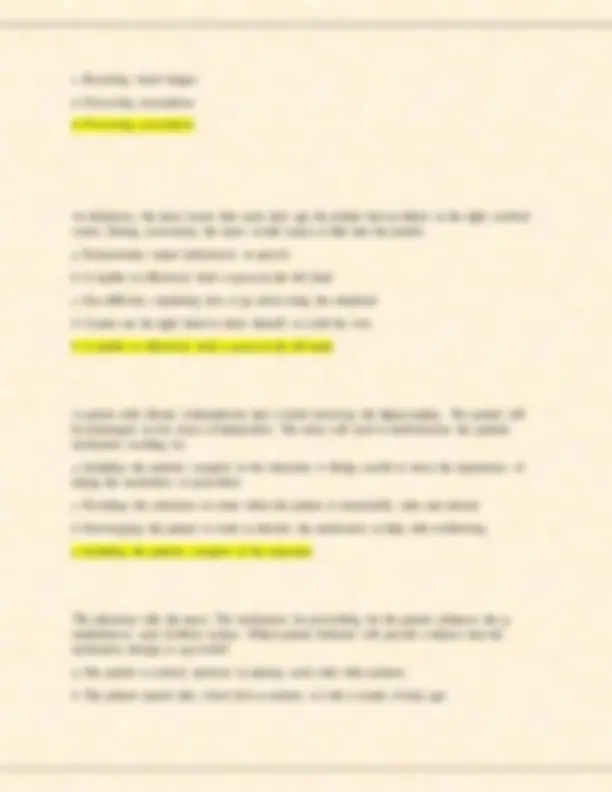
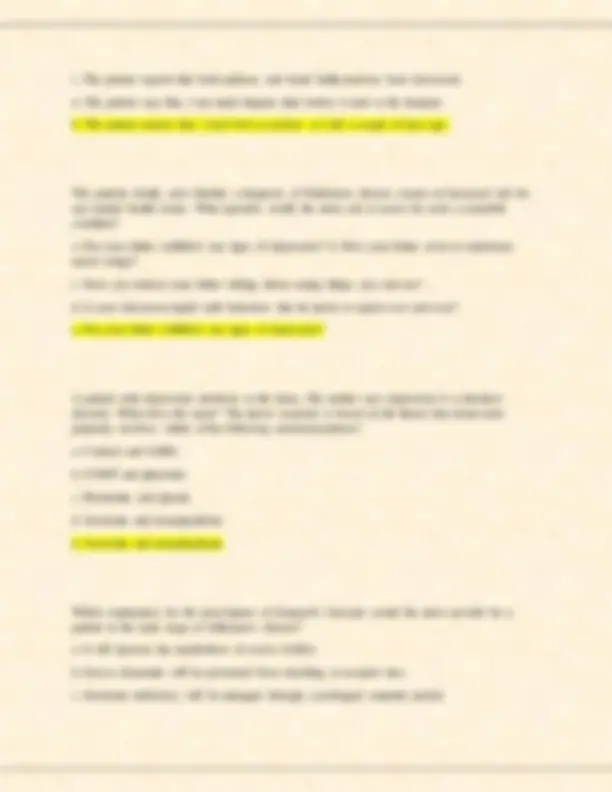
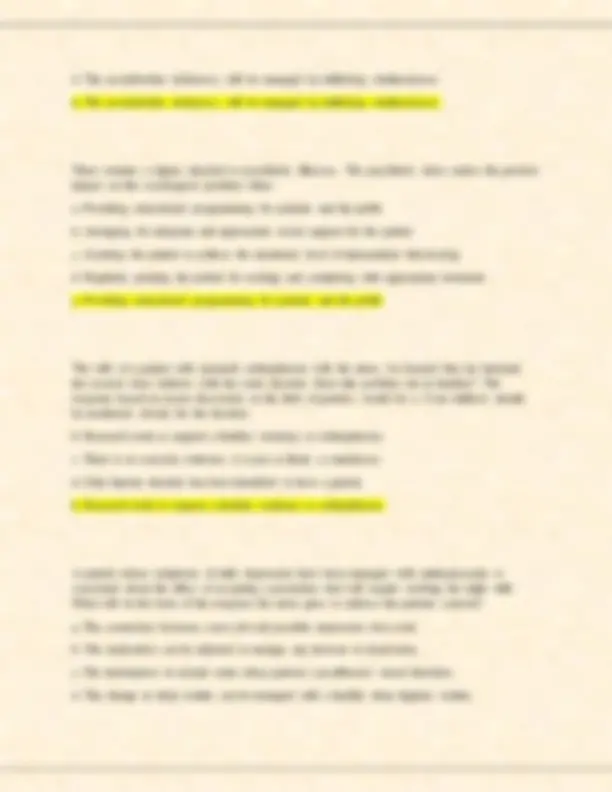
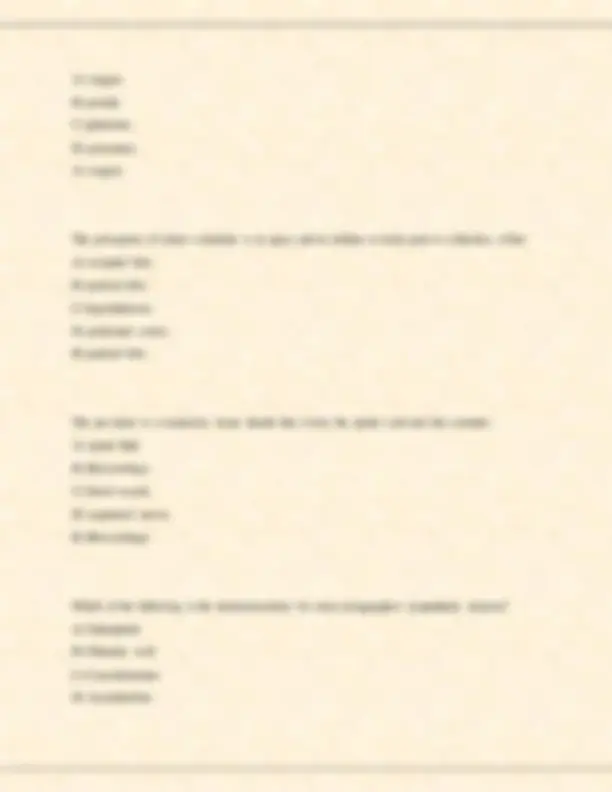
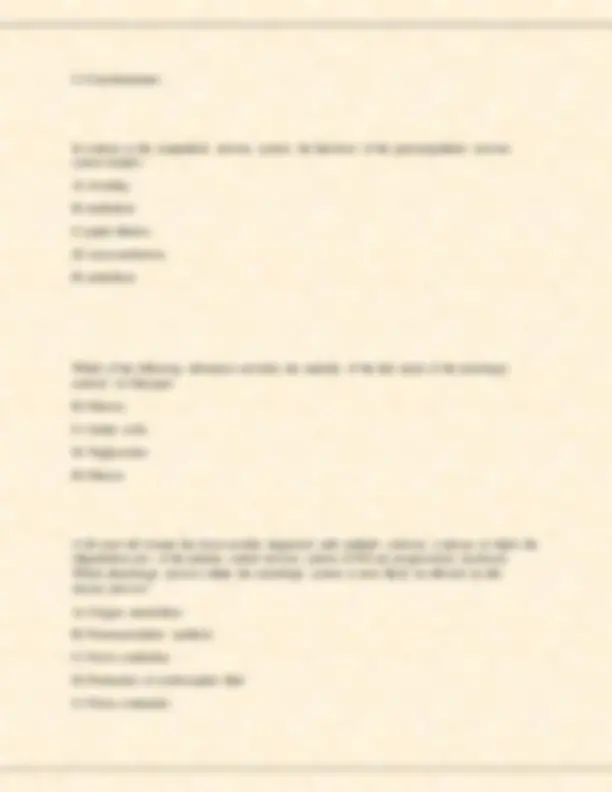
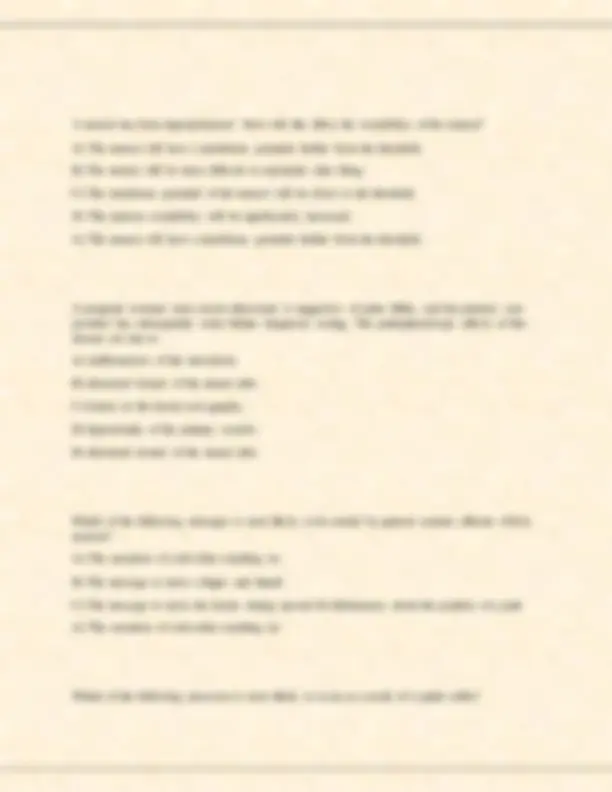


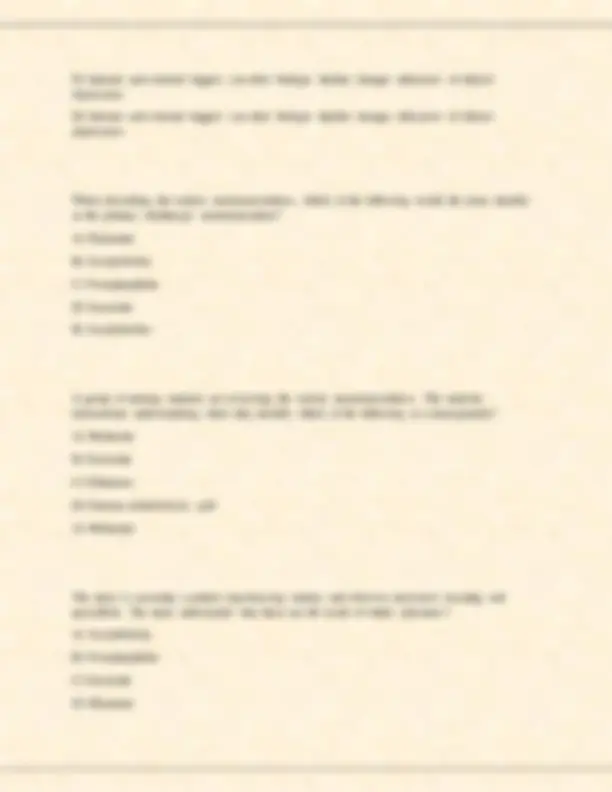


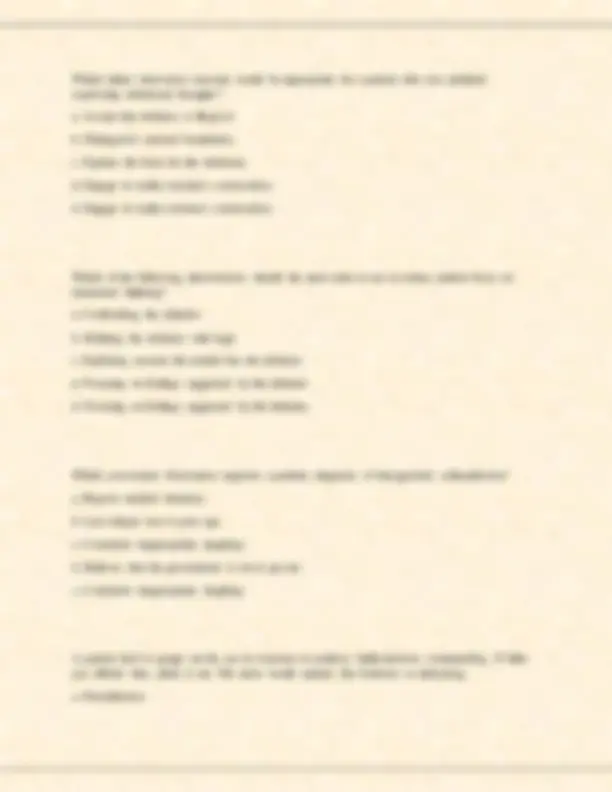

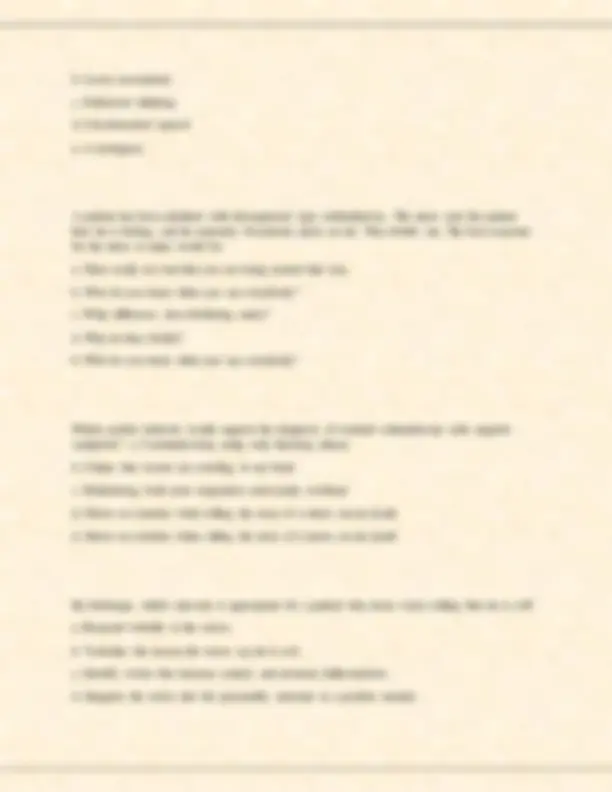
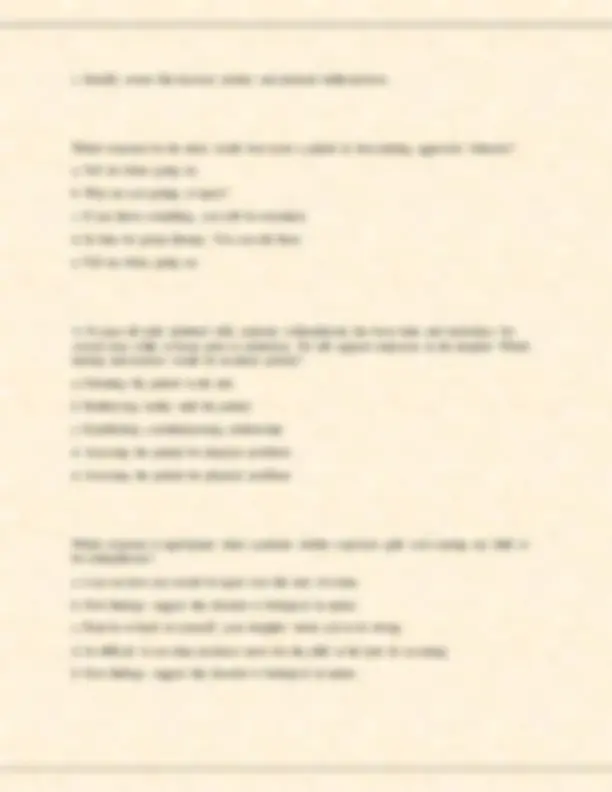
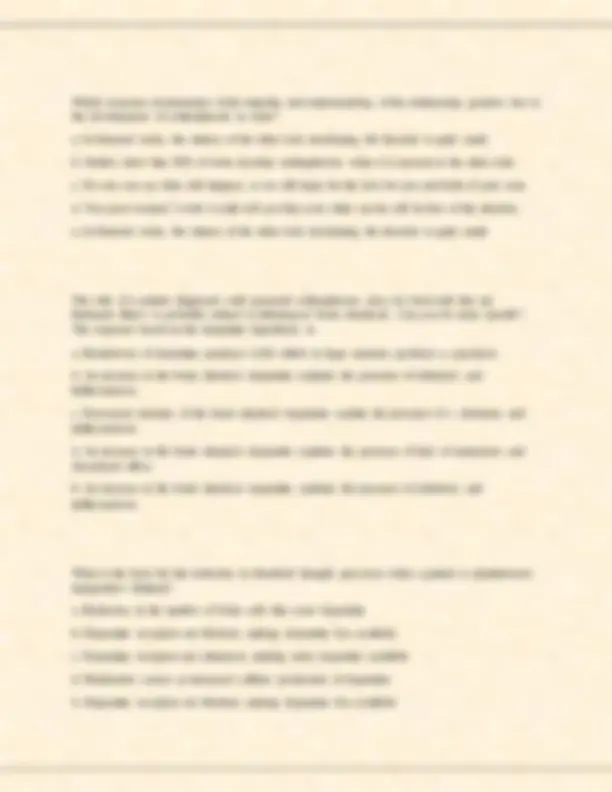
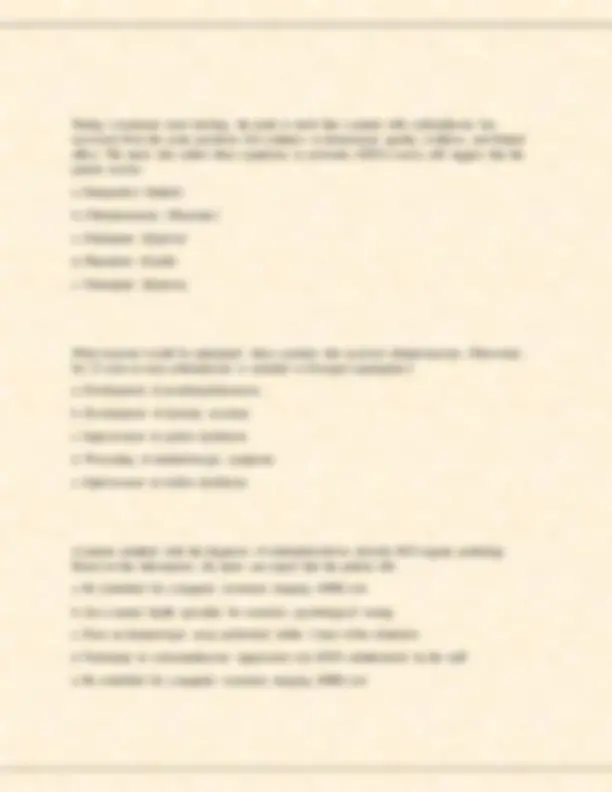
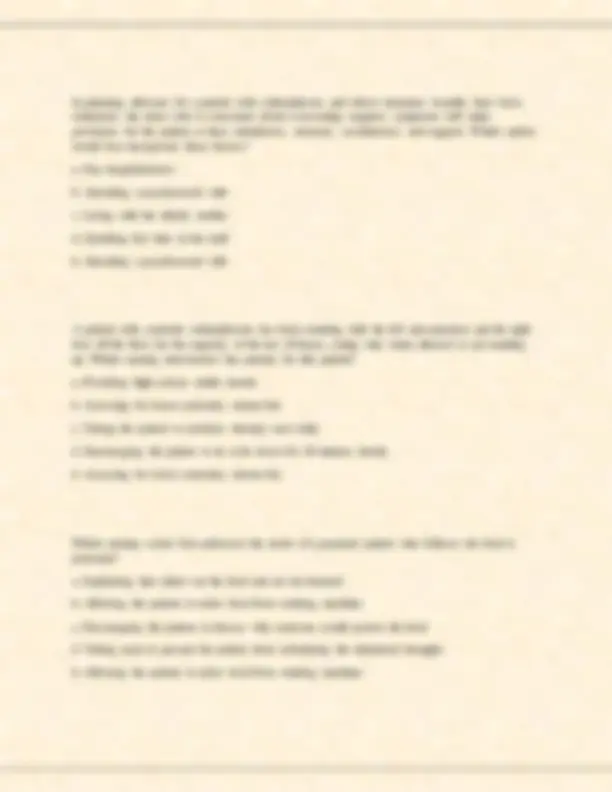

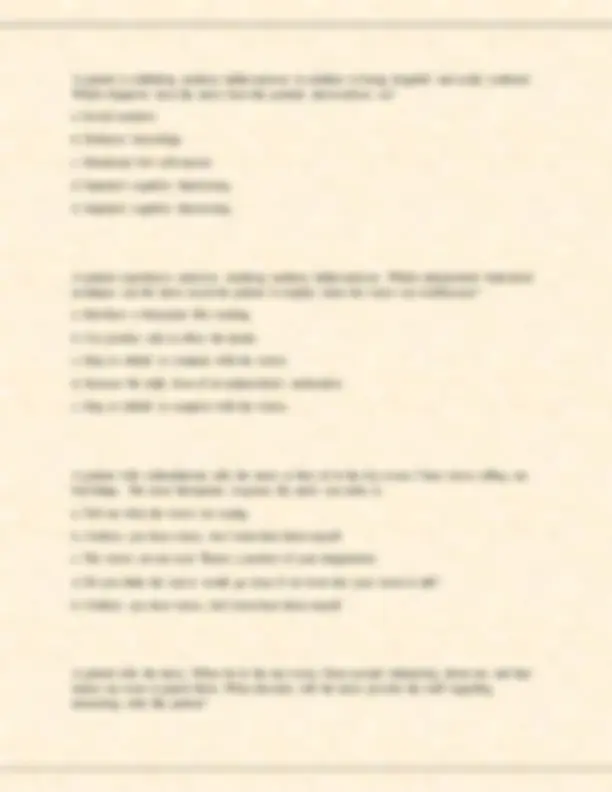

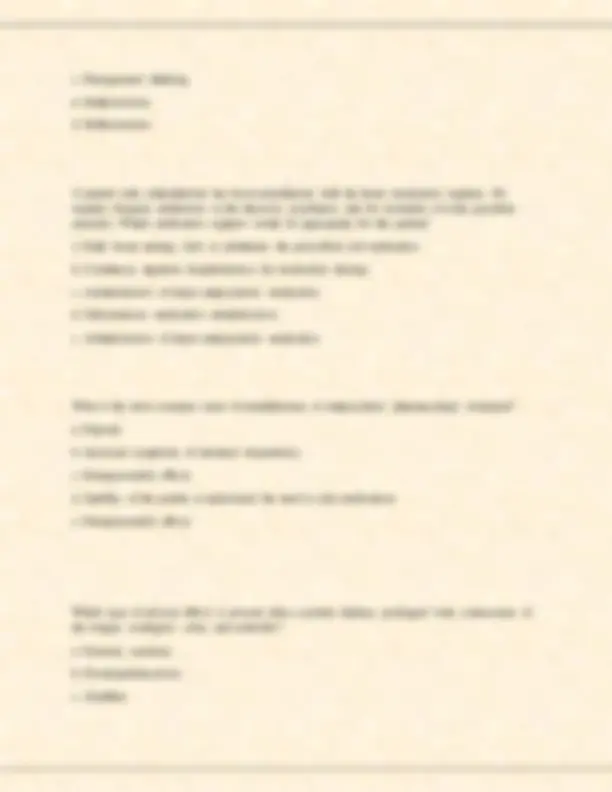
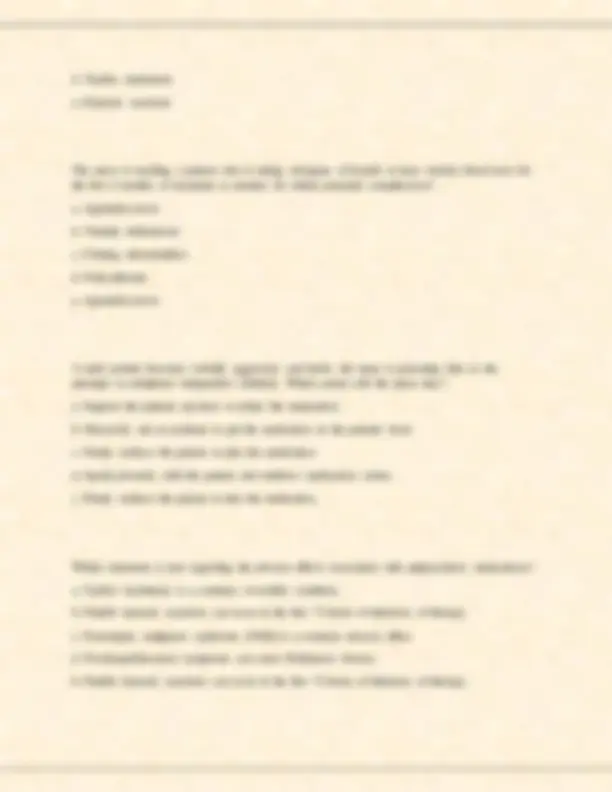
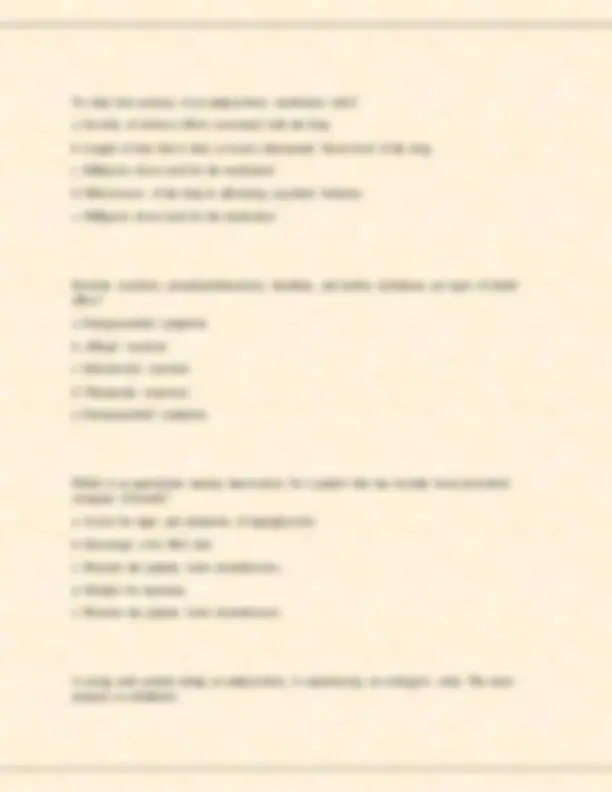

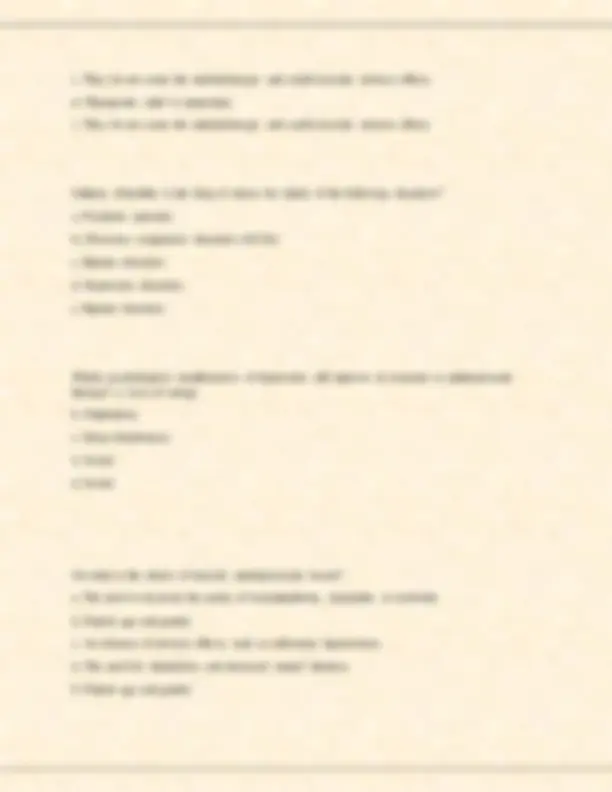
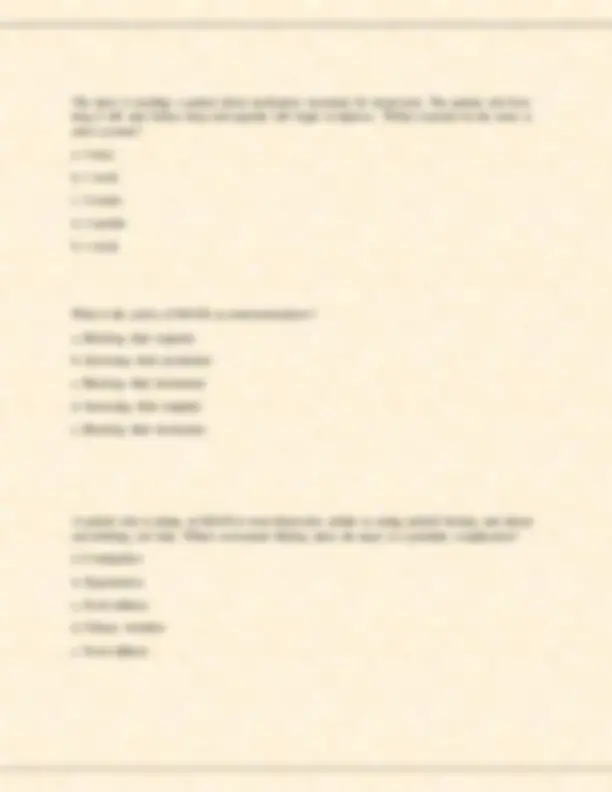
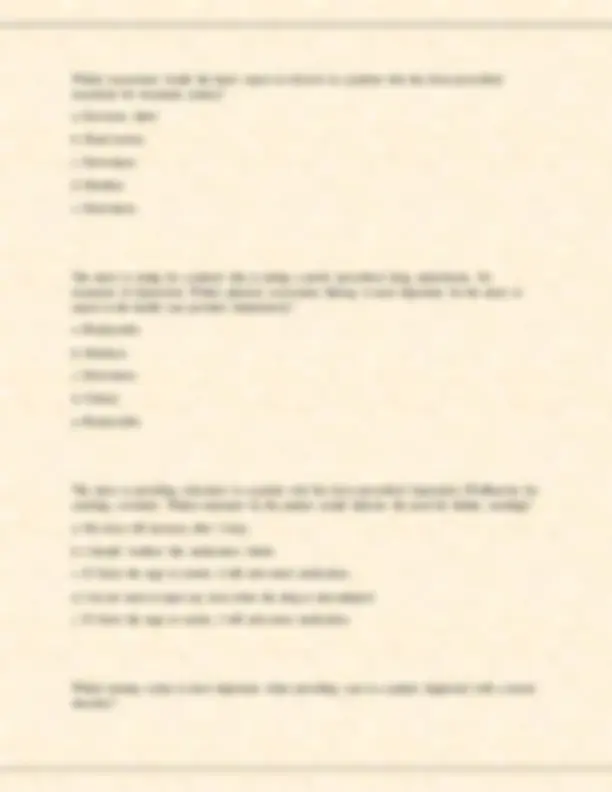

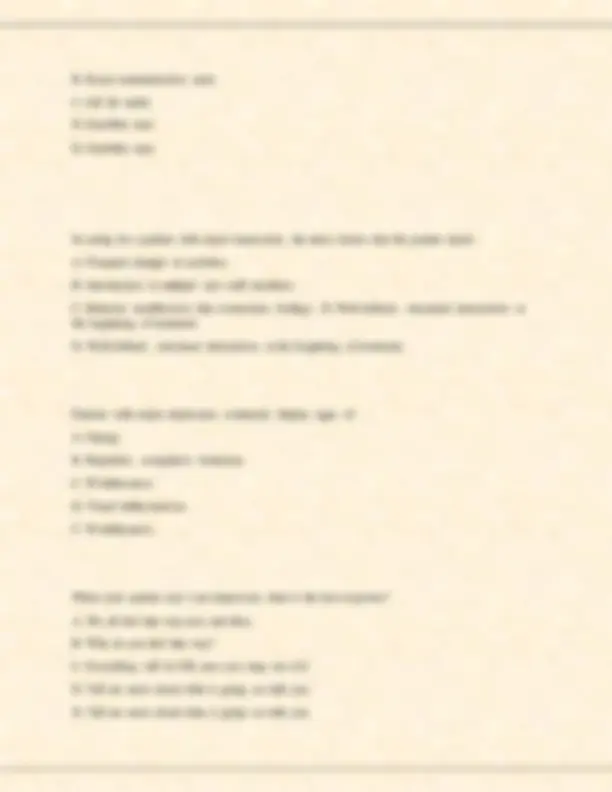
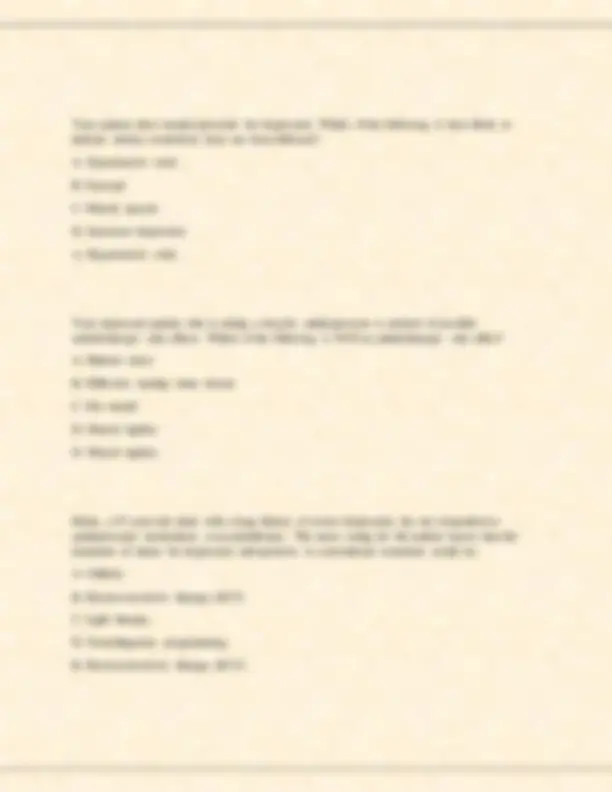
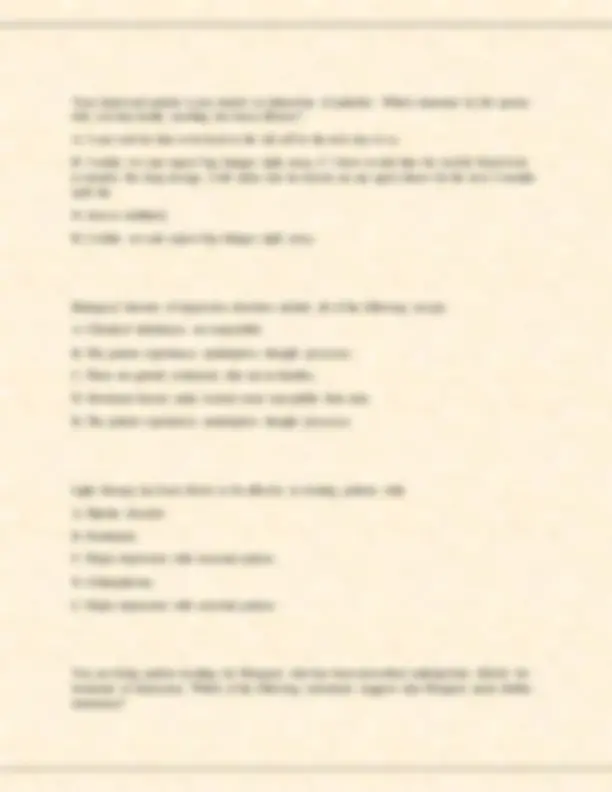

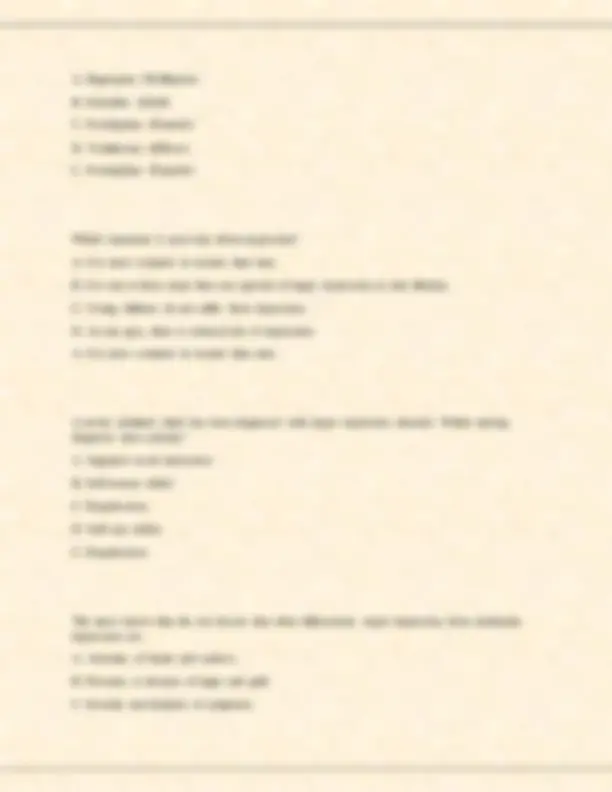
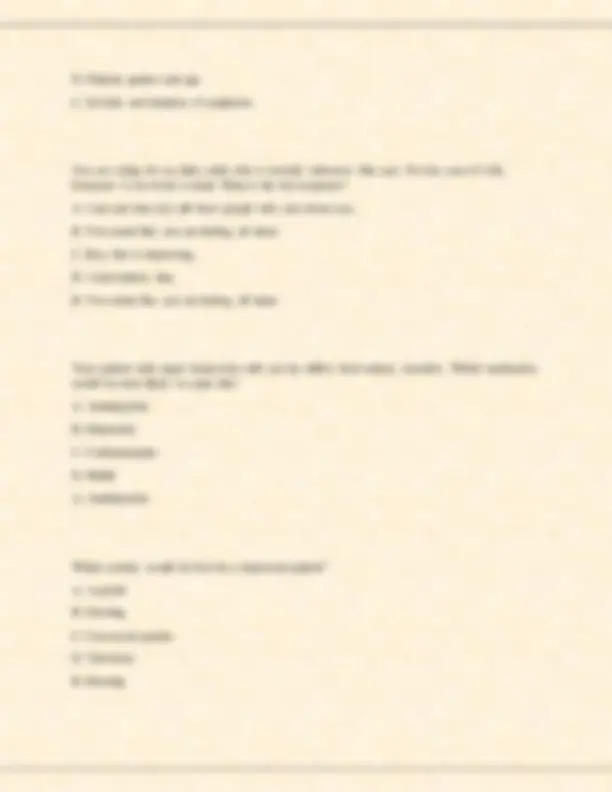
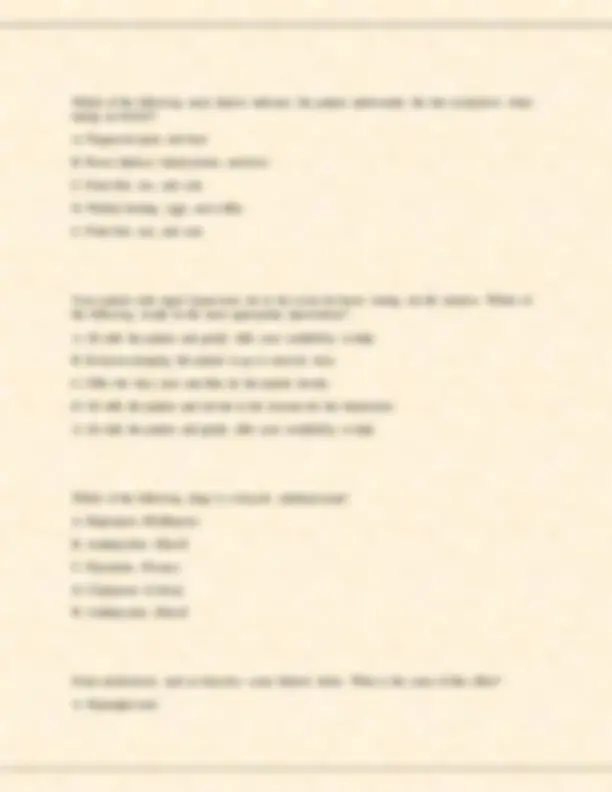

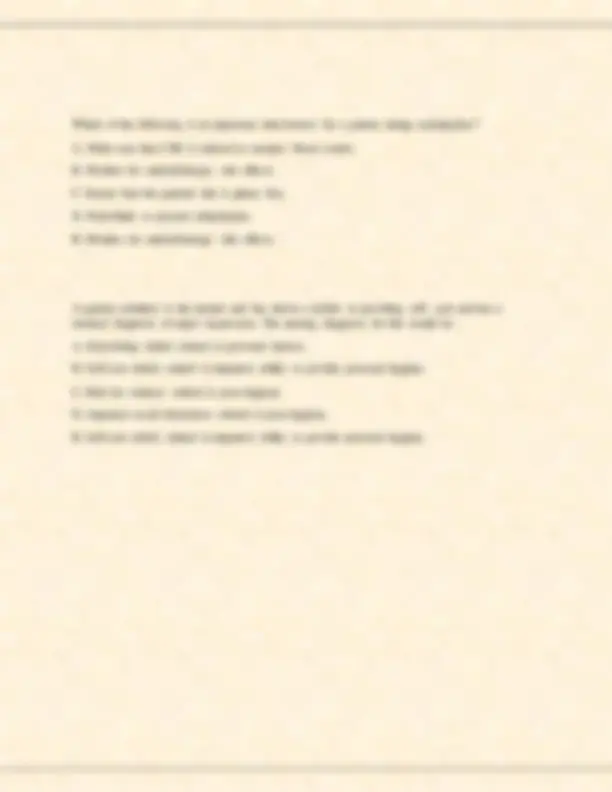


Study with the several resources on Docsity

Earn points by helping other students or get them with a premium plan


Prepare for your exams
Study with the several resources on Docsity

Earn points to download
Earn points by helping other students or get them with a premium plan
Community
Ask the community for help and clear up your study doubts
Discover the best universities in your country according to Docsity users
Free resources
Download our free guides on studying techniques, anxiety management strategies, and thesis advice from Docsity tutors
Exam 1: NSG552 / NSG 552 (Latest 2025 / 2026): Psychopharmacology | Grade A | Questions and Verified Answers | 100% Correct – Wilkes
Typology: Exams
1 / 46

This page cannot be seen from the preview
Don't miss anything!







































A nurse is teaching a medication class to a group of psychiatric patients. One of them asks the nurse why he has so much more trouble learning now when he's in his 60s than he did when he was younger. Which of the following concepts would the nurse integrate into the response? A) The extrapyramidal motor system B) The amygdala C) Neuroplasticity D) Psychoneuroimmunology C) Neuroplasticity A patient has experienced a stroke (cerebral vascular accident) that has resulted in damage to the Broca area. Which evaluation does the nurse conduct to reinforce this diagnosis? a. Observing the patient pick up a spoon b. Asking the patient to recite the alphabet c. Monitoring the patients blood pressure d. Comparing the patients grip strength in both b. Asking the patient to recite the alphabet The patient diagnosed with schizophrenia asks why psychotropic medications are always prescribed by the doctor. The nurses answer will be based on information that the therapeutic action of psychotropic drugs is the result of their effect on: a. The temporal lobe; especially Wernickes area b. Dendrites and their ability to transmit electrical impulses c. The regulation of neurotransmitters especially dopamine
d. The peripheral nervous system sensitivity to the psychotropic medications c. The regulation of neurotransmitters especially dopamine A student nurse mutters that it seems entirely unnecessary to have to struggle with understanding the anatomy and physiology of the neurologic system. The mentor would base a response on the understanding that it is: a. Necessary but generally for psychiatric nurses who focus primarily on behavioral interventions b. A complex undertaking that advance practice psychiatric nurses frequently use in their practice c. Important primarily for the nursing assessment of patients with brain trauma caused cognitive symptoms d. Necessary for planning psychiatric care for all patients especially those experiencing psychiatric disorders d. Necessary for planning psychiatric care for all patients especially those experiencing psychiatric disorders A patient asks the nurse, My wife has breast cancer. Could it be caused by her chronic depression? Which response is supported by research data? a. Too much stress has been proven to cause all kinds of cancer. b. There have been no research studies done on stress and disease yet. c. Stress does cause the release of factors that suppress the immune system. d. There appears to be little connection between stress and diseases of the body c. Stress does cause the release of factors that suppress the immune system. A patient who has a parietal lobe injury is being evaluated for psychiatric rehabilitation needs. Of the aspects of functioning listed, which will the nurse identify as a focus of nursing intervention? a. Expression of emotion b. Detecting auditory stimuli
c. The patient reports that both auditory and visual hallucinations have decreased. d. The patient says that, I am much happier than before I came to the hospital. b. The patient reports that, I don't feel as anxious as I did a couple of days ago. The patients family asks whether a diagnosis of Parkinsons disease creates an increased risk for any mental health issues. What question would the nurse ask to assess for such a comorbid condition? a. Has your father exhibited any signs of depression? b. Does your father seem to experience mood swings? c. Have you noticed your father talking about seeing things you cant see? d. Is your dad preoccupied with behaviors that he needs to repeat over and over? a. Has your father exhibited any signs of depression? A patient with depression mentions to the nurse, My mother says depression is a chemical disorder. What does she mean? The nurses response is based on the theory that depression primarily involves which of the following neurotransmitters? a. Cortisol and GABA b. COMT and glutamate c. Monamine and glycine d. Serotonin and norepinephrine d. Serotonin and norepinephrine Which explanation for the prescription of donepezil (Aricept) would the nurse provide for a patient in the early stage of Alzheimers disease? a. It will increase the metabolism of excess GABA. b. Excess dopamine will be prevented from attaching to receptor sites. c. Serotonin deficiency will be managed through a prolonged reuptake period.
d. The acetylcholine deficiency will be managed by inhibiting cholinesterase. d. The acetylcholine deficiency will be managed by inhibiting cholinesterase. There remains a stigma attached to psychiatric illnesses. The psychiatric nurse makes the greatest impact on this sociological problem when: a. Providing educational programming for patients and the public b. Arranging for adequate and appropriate social support for the patient c. Assisting the patient to achieve the maximum level of independent functioning d. Regularly praising the patient for seeking and complying with appropriate treatment a. Providing educational programming for patients and the public The wife of a patient with paranoid schizophrenia tells the nurse, Ive learned that my husband has several close relatives with the same disorder. Does this problem run in families? The response based on recent discoveries in the field of genetics would be: a. Your children should be monitored closely for the disorder. b. Research tends to support a familiar tendency to schizophrenia. c. There is no concrete evidence; it is just as likely a coincidence. d. Only bipolar disorder has been identified to have a genetic b. Research tends to support a familiar tendency to schizophrenia. A patient whose symptoms of mild depression have been managed with antidepressants is concerned about the affect of accepting a promotion that will require working the night shift. What will be the basis of the response the nurse gives to address the patients concern? a. The connection between a new job and possible depression does exist. b. The medication can be adjusted to manage any increase in depression. c. The interruption in normal wake-sleep patterns can influence mood disorders. d. The change in sleep routine can be managed with a healthy sleep hygiene routine.
Supporting cells of the nervous system, such as Schwann cells, satellite cells, and types of glial cells, function to provide neurons with: A) local protection. B) control functions. C) membrane permeability. D) integrative metabolism. A) local protection. Neurons are characterized by the ability to communicate with other neurons and body cells through: A) astrocytes. B) axon hillocks. C) nodes of Ranvier. D) action potentials. D) action potentials. Chemical synapses rely on in order to provide communication between neurons. A) diffusion B) gap junctions C) satellite cells D) transmitter molecules D) transmitter molecules The blood-brain and CSF-brain barriers control the chemical environment of the brain by allowing easy entrance to only a few chemicals that include:
A) oxygen. B) protein. C) glutamate. D) potassium. A) oxygen. The perception of where a stimulus is in space and in relation to body parts is a function of the: A) occipital lobe. B) parietal lobe. C) hypothalamus. D) prefrontal cortex. B) parietal lobe. The pia mater is a connective tissue sheath that covers the spinal cord and also contains: A) spinal fluid. B) fibrocartilage. C) blood vessels. D) segmental nerves. B) fibrocartilage. Which of the following is the neurotransmitter for most postganglion sympathetic neurons? A) Enkephalin B) Glutamic acid C) Catecholamines D) Acetylcholine
A neuron has been hyperpolarized. How will this affect the excitability of the neuron? A) The neuron will have a membrane potential farther from the threshold. B) The neuron will be more difficult to repolarize after firing. C) The membrane potential of the neuron will be closer to the threshold. D) The neurons excitability will be significantly increased. A) The neuron will have a membrane potential farther from the threshold. A pregnant womans most recent ultrasound is suggestive of spina bifida, and her primary care provider has subsequently order further diagnostic testing. The pathophysiologic effects of this disease are due to: A) malformation of the mesoderm. B) abnormal closure of the neural tube. C) lesions in the dorsal root ganglia. D) hypertrophy of the primary vesicles. B) abnormal closure of the neural tube. Which of the following messages is most likely to be carried by general somatic afferent (GSA) neurons? A) The sensation of cold when touching ice B) The message to move a finger and thumb C) The message to move the larynx during speech D) Information about the position of a joint A) The sensation of cold when touching ice Which of the following processes is most likely to occur as a result of a spinal reflex?
A) Peristalsis of the small and large bowel B) Control of oculomotor function in changing light levels C) Pain sensation from a potentially damaging knee movement D) Withdrawal of a hand from a hot stove element D) Withdrawal of a hand from a hot stove element A patient has required mechanical ventilation following a traumatic head injury sustained in a motorcycle crash, during which he sustained damage to his respiratory center. Which of the patient's brain structures has been injured? A) Brain stem B) Midbrain C) Diencephalon D) Frontal lobe A) Brain stem A patient with a diagnosis of epilepsy has required surgical removal of part of her prefrontal cortex. Which of the following effects should her family and care team anticipate? A) Lapses in balance and coordination B) Deficits in regulation of the endocrine system C) Sensory losses D) Changes in behavior and judgment D) Changes in behavior and judgment A patient's primary care provider has prescribed a b-adrenergic receptor blocker. Which of the following therapeutic effects do the patient and care provider likely seek? A) Reduction in heart rate and blood pressure
D) The hippocampus B) Brocas area The nurse is caring for an older adult who has experienced damage to the frontal lobe after an automobile accident. The nurse anticipates that the patient will have difficulty with which of the following? A) Smell B) Concept formation C) Receptive speech D) Hearing B) Concept formation The nurse is caring for a patient who has experienced damage to the parietal lobes of the brain. The nurse anticipates that the patient with have difficulty with which of the following? A) Perceiving sensory input B) Calculating a math problem C) Seeing objects in front of him D) Speaking fluently B) Calculating a math problem A patient has been diagnosed with memory dysfunction associated with Alzheimers disease. The nurse determines that damage to the patients brain includes deterioration of temporal lobe structures and the nerves of which of the following? A) Basal ganglia B) Limbic system C) Frontal lobe
D) Hippocampus D) Hippocampus The nurse is caring for a hospitalized patient who has a disorder of the hypothalamus. When developing the patients plan of care, in which of the following areas would the nurse anticipate a problem? A) Sleep B) Constipation C) Speech D) Motor activity A) Sleep A patient who is scheduled to undergo a sleep deprivation electroencephalogram (EEG) in the morning is experiencing moderate anxiety about the procedure. Based on an understanding of this test, which of the following would the nurse avoid? A) Explaining in depth what to expect during the upcoming procedure B) Administering a benzodiazepine medication prescribed for anxiety C) Taking a thorough history of her use of prescribed and illicit drugs D) Giving her a noncaffeinated beverage of her choice B) Administering a benzodiazepine medication prescribed for anxiety A nursing instructor asks a student to explain the influence of chronobiology on depression. Which of the following would the student include when responding? A) The exact location of genes leads to identifying the gene responsible for causing depression. B) A break in the corpus coliseum blocks information exchange between the right and left hemispheres. C) Damage to the posterior areas of the parietal lobe leads to altered discriminative sensory function.
B) Norepinephrine A nurse is developing a plan of care for a patient diagnosed with schizophrenia. The nurse integrates knowledge of this disorder, identifying which neurotransmitter as being primarily involved? A) Acetylcholine B) Dopamine C) Norepinephrine D) Serotonin B) Dopamine A group of students are reviewing information about neurotransmitter subtypes. The group demonstrates understanding of the information when they identify which neurotransmitter as having muscarinic and nicotinic receptors? A) Serotonin B) Gamma-aminobutyric acid (GABA) C) Dopamine D) Acetylcholine D) Acetylcholine A nurse is involved in gathering information about the inheritance of mental disorders using population genetics. Which of the following would the nurse be least likely to be evaluating? A) Concordance rates B) Occurrence in first-degree relatives C) Risk factor analysis D) Adoptions studies C) Risk factor analysis
A nurse is reading a journal article about psychoneuroimmunology. Which 16. information would the nurse most likely find? Select all that apply. A) Neurotoxins role in receptor site damage B) Hypothalamicpituitarythyroid axis disruption C) Static activity of natural killer cells in response to stress D) Hypothalamic damage leading to immune dysfunction E) Interruption in the typical circadian rhythm cycle A) Neurotoxins role in receptor site damage B) Hypothalamicpituitarythyroid axis disruption D) Hypothalamic damage leading to immune dysfunction A patient is scheduled for a challenge test. Which of the following would the nurse include when explaining this test to the patient? A) Intravenous administration of a substance to induce symptoms B) Application of electrodes to the scalp for monitoring C) Evaluation electrical impulses recorded on graph paper D) Exposure to a flashing strobe light to elicit abnormal activity A) Intravenous administration of a substance to induce symptoms A patient with depression tells the nurse that he is to have a test that involves the recording of an electroencephalogram (EEG) throughout the night. The 18. nurse most likely identifies this testing as which of the following? A) Sleep deprivation EEG B) Polysomnography C) Evoked potentials D) Functional magnetic resonance imaging
What would be an appropriate short-term outcome for a patient diagnosed with residual schizophrenia who exhibits ambivalence? a. Decide their own daily schedule. b. Decide which unit groups they will attend. c. Choose which clinic staff member to work with. d. Choose between two outfits to wear each morning. d. Choose between two outfits to wear each morning. What is the priority nursing diagnosis for a catatonic patient? a. Ineffective coping b. Impaired physical mobility c. Impaired social interaction d. Risk for deficient fluid volume d. Risk for deficient fluid volume Which nursing diagnosis is appropriate for a patient who insists being called Your Highness and demonstrates loosely associated thoughts? a. Risk for violence b. Defensive coping c. Impaired memory d. Disturbed thought processes d. Disturbed thought processes
Which initial short-term outcome would be appropriate for a patient who was admitted expressing delusional thoughts? a. Accept that delusion is illogical. b. Distinguish external boundaries. c. Explain the basis for the delusions. d. Engage in reality-oriented conversation. d. Engage in reality-oriented conversation. Which of the following interventions should the nurse plan to use to reduce patient focus on delusional thinking? a. Confronting the delusion b. Refuting the delusion with logic c. Exploring reasons the patient has the delusion d. Focusing on feelings suggested by the delusion d. Focusing on feelings suggested by the delusion Which assessment observation supports a patients diagnosis of disorganized schizophrenia? a. Reports suicidal ideations b. Last relapse was 6 years ago c. Consistent inappropriate laughing d. Believes that the government is out to get me c. Consistent inappropriate laughing A patient tried to gouge out his eye in response to auditory hallucinations commanding, If thine eye offends thee, pluck it out. The nurse would analyze this behavior as indicating: a. Derealization